Social Care Services, Scotland, 2014
Information on Home Care Services, Direct Payments, Community Alarms and Telecare, Meals services and Housing Support Services.
This document is part of a collection
3. Older People - Clients aged 65+
Older People constitute the majority of Social Care clients (see Figure 7). This section provides more detail on the 117,910 Social Care clients aged 65+.
3.1 Home Care for clients aged 65+
There were 50,440 Home Care clients aged 65+ in March 2014. Figure 11 shows that the rate per population of clients aged 65+ receiving Home Care has remained around 53 per 1,000 population since 2012, following a steady decrease since 2005.
Figure 11: Home Care clients per 1,000 population aged 65+, 2005 to 2014
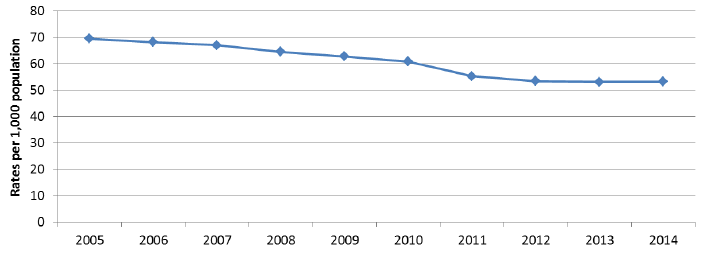
Source: Social Care Survey 2013 and 2014, Home Care Census (pre 2013)
Population data: National Records for Scotland mid-year population estimates up to 2013 (latest available).
Figure 12 shows the number of people aged 65+ receiving Home Care has remained stable between 2013 and 2014, following decreases in each of the preceding three years. However, the number of Home Care hours provided has increased every year since 2011. This indicates that the intensity (hours per person per week) of Home Care provided has been increasing over the past four years
Figure 12: Home Care clients aged 65+ and hours provided, 2010 to 2014
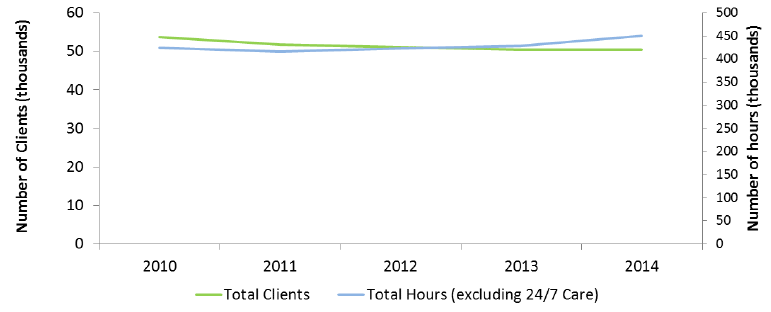
Source: Social Care Survey 2013 and 2014, Home Care Census (pre 2013)
Figure 13 shows that the number of Home Care clients aged 65+ receiving more than 20 hours of care per week in March 2014 was relatively small.
Figure 13: Home Care clients aged 65+ by level of service, 2014
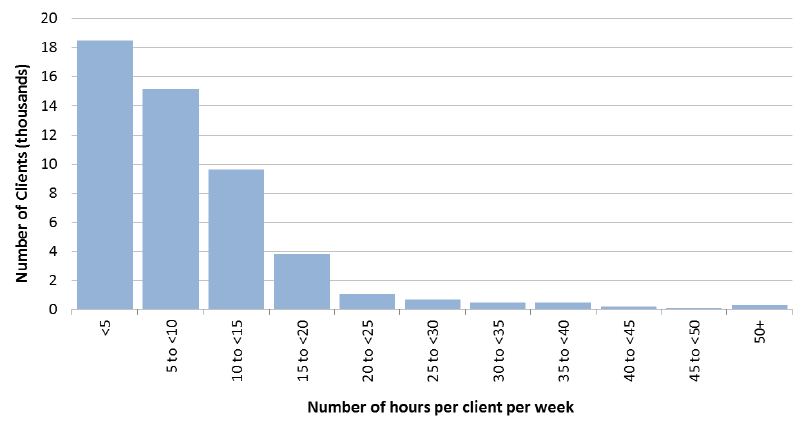
Source: Social Care Survey 2014
Table 2 shows that 55% of Home Care clients aged 65+ in March 2014 received their care solely from Local Authorities. It also provides two measures of the average hours of care provided per week to clients aged 65+, by service provider. The mean gives the average in the sense of the total divided by the number of clients. The median gives the average in the sense of the "middle" value, such that half of values are greater than it and half less. The median is less susceptible to outliers (i.e. very high volumes of care that could skew the figures) and these values are seen to be generally lower than the means. Both the mean and median numbers of hours provided per week are lowest for "Local Authority only" clients.
Table 2: Home Care for clients aged 65+, by service provider, 2014
| Service Provider |
Number of clients |
% |
Client hours |
% |
Average (mean) hours per week |
Average (median) hours per week |
|---|---|---|---|---|---|---|
| Local Authority only |
27,990 |
55% |
207,600 |
46% |
7 |
6 |
| Private sector only |
17,490 |
35% |
170,600 |
38% |
10 |
7 |
| Voluntary sector only |
1,540 |
3% |
24,500 |
5% |
16 |
8 |
| LA plus private |
2,310 |
5% |
31,100 |
7% |
13 |
12 |
| LA plus voluntary |
730 |
1% |
10,800 |
2% |
15 |
11 |
| All other combinations |
320 |
1% |
5,400 |
1% |
17 |
14 |
| Total |
50,440 |
100% |
450,000 |
100% |
9 |
7 |
Source: Social Care Survey 2014
Figure 14 shows the distribution of March 2014 Home Care clients aged 65+ by client group, along with a further age breakdown. Clients with a Learning Disability are, on average, younger than the other client groups.
Figure 14: Home Care Clients aged 65+ by Client group and age group, 2014
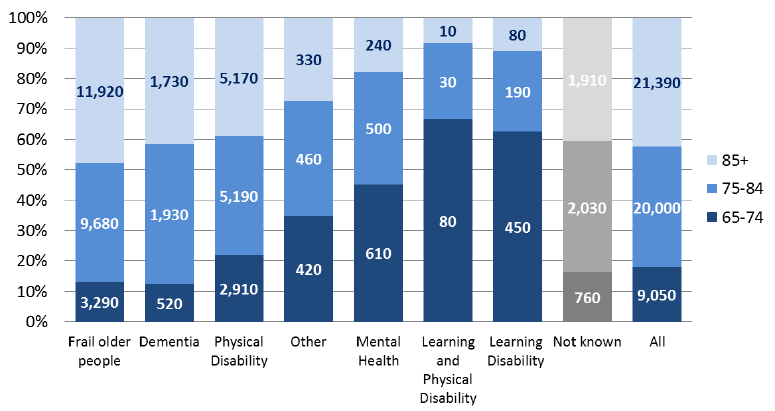
Note: "Dementia" is known to be under recorded in the social care management information system.
Source: Social Care Survey 2014
Figure 15 shows that of the March 2014 Home Care clients aged 65+ for whom living arrangements are known, around two thirds (65%) live alone. This figure is higher for female clients, for whom 69% live alone.
Figure 15: Living arrangement of clients aged 65+ receiving Home Care services, 2014
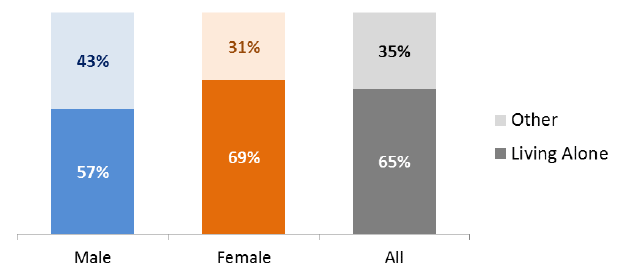
Living arrangements information was unavailable for 13,380 clients.
Source: Social Care Survey 2014
3.2 Community Alarm / Telecare Services for clients aged 65+
From 2010 onwards information has been collected on clients who use services other than Home Care in their own home. This includes Community Alarms and other Telecare services. Trends over time therefore are presented from 2011 onwards as a number of Local Authorities were not able to provide information on all the clients in receipt of a Community Alarm and/or another Telecare Service in 2010. The Background Information provided in this report contains definitions of Community Alarm and 'other Telecare services.
In March 2014, 94,680 people aged 65+ made use of a Community Alarm and/or another Telecare Service. Most of these had only a Community Alarm.
Figure 16: Distribution of clients aged 65+ receiving Community Alarm and/or another Telecare service, by client group, 2014
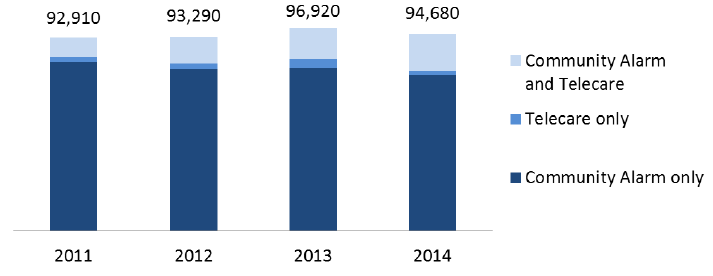
Source: Social Care Survey 2014
3.3 Meals Services for clients aged 65+
Data on Meals services provided at home has proved difficult for Local Authorities to capture, and as such the figures presented here; i) are likely to be less than the true figures, and ii) should not be compared with previous years' figures to gauge changes in provision. Figure 17 (over the page) shows that the majority of clients aged 65+ who received meals services in March 2014 were in receipt of hot meals. Half of Meals services clients aged 65+ were aged 85+.
Figure 17: Clients aged 65+ receiving Hot or Frozen Meals, by age, 2014
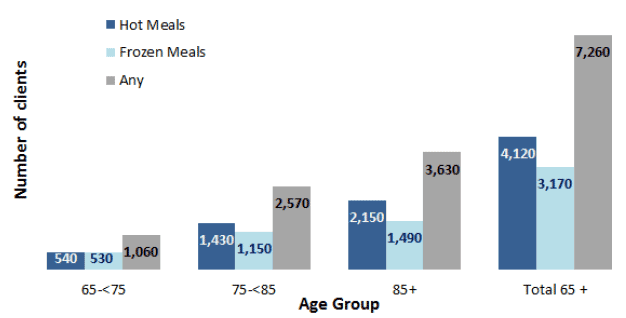
Source: Social Care Survey 2014
Note: Some clients receive both hot and frozen meals.
Note: Three Local Authorities did not submit Meals data for 2014. Direct comparisons should not be made with 2013.
3.4 Direct Payments for clients aged 65+
In 2013-14, 2,310 people aged 65+ received Direct Payments. The total amount spent by Local Authorities on Direct Payments to this age group in 2013-14 was £20.8 million. 2013-14 saw the continuation of the trend of increasing numbers of people receiving Direct Payments. Figure 18 shows the increase in Direct Payment clients aged 65+ over the last ten years.
Figure 18: Number of people aged 65+ receiving direct payments, 2004-05 to 2013-14
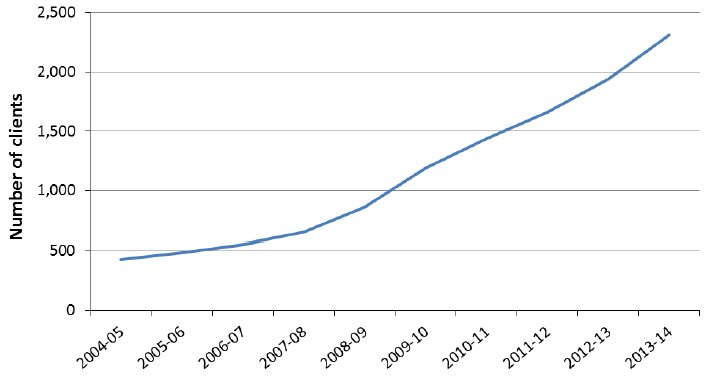
Source: Social Care Survey 2013 and 2014, Self-directed Support (Direct Payments) Survey (pre 2013)
Table 3 shows the breakdown of 2013-14 clients aged 65+ receiving Direct Payments by client group. Frailty due to old age is the primary reason for clients in this age group receiving Direct Payments, followed by Physical Disabilities and Dementia.
Table 3: Direct Payments for clients aged 65+, by client group, 2013-14
| Client Group |
Number of clients* |
Expenditure |
Mean1 value of |
Median2 value of |
|---|---|---|---|---|
| Frail older people |
1,060 |
£9.8 |
£9,000 |
£7,000 |
| Physical disability |
610 |
£5.4 |
£9,000 |
£5,000 |
| Dementia |
300 |
£2.7 |
£9,000 |
£6,000 |
| Learning disability |
180 |
£1.2 |
£7,000 |
£3,000 |
| Mental Health |
60 |
£0.7 |
£11,000 |
£7,000 |
| Not known |
50 |
£0.5 |
£9,000 |
£7,000 |
| Other |
30 |
£0.5 |
£14,000 |
£9,000 |
| Learning and Physical disability |
10 |
£0.0 |
£4,000 |
£4,000 |
| All |
2,310 |
£20.8 |
£9,000 |
£6,000 |
* Rounded to the nearest 10. Some clients receive more than one Direct Payment
1 The mean is the sum of all payments divided by the number of payments (rounded to nearest £1,000)
2 The median is the "middle" value of direct payments, i.e. the value at which half of the payments are less and half are more (rounded to nearest £1,000).
Note: "Dementia" is known to be under recorded in the social care management information system.
Source: Social Care Survey 2014
Contact
Email: Steven Gillespie
There is a problem
Thanks for your feedback